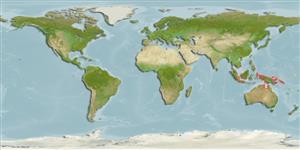>
Eupercaria/misc (Various families in series Eupercaria) >
Sciaenidae (Drums or croakers)
Eponymy: Rev Dr Christoph Samuel John (1747–1813) was a botanist and herpetologist and a medical missionary (1771–1813) at the Danish trading station of Tranquebar (now Tharangambadi), Tamil Nadu, not far from Madras (Chennai). [...] (Ref. 128868), visit book page.
More on author: Nichols.
Environment: milieu / climate zone / depth range / distribution range
Ekologi
marina; brackvatten bentopelagisk. Tropical
Western Central Pacific: New Guinea and northern Australia.
Size / Vikt / Age
Maturity: Lm ? range ? - ? cm
Max length : 9.0 cm SL hane/ej könsbestämd; (Ref. 9772); common length : 7.0 cm SL hane/ej könsbestämd; (Ref. 9772)
Taggstrålar i ryggfenan (totalt) : 8 - 10; Mjukstrålar i ryggfenan (totalt) : 25 - 30; Taggstrålar i analfenan: 2; Mjukstrålar i analfenan: 6 - 8. Head swollen and deep. Eye very small, 11 to 16 % of head length; snout very steeply rounded, but not swollen or projecting; mouth very large, strongly oblique; no barbel; no upper rostral pores; mental pores in one pair only, open behind symphysis; teeth well differentiated into large and small in both jaws; gill rakers long, slender, equal to or longer than gill filaments at angle, 16 to 18 on lower limb. Dorsal fin with VII to IX (most frequently VIII) spines. Second anal spine long, slender, 31 to 44 % of head length; caudal fin acutely pointed. Swim bladder hammer-shaped, with 11 pairs of arborescent appendages along its side, the first pair entering head beyond transverse septum and sending a palmate branch to the front of pectoral arch. Sagitta (large earstone) with tadpole-shaped impression, the head of which has its long axis lying obliquely to that of sagitta and the tail expanded and deepened as a hollow cone connected with the head by a narrow groove.
Inhabits estuaries and rivers (Ref. 9772).
Life cycle and mating behavior
Könsmognad | Reproduktion | Lek | Ägg | Fecundity | Larver
Sasaki, K., 2001. Sciaenidae. Croakers (drums). p.3117-3174. In K.E. Carpenter and V.H. Niem (eds.) FAO species identification guide for fishery purposes. The living marine resources of the Western Central Pacific. Volume 5. Bony fishes part 3 (Menidae to Pomacentridae). Rome, FAO. pp. 2791-3380. (Ref. 9772)
IUCN Red List Status (Ref. 130435: Version 2024-1)
Threat to humans
Harmless
Human uses
Fiskeri: saknar intresse
Verktyg
Special reports
Download XML
Internet-källor
Estimates based on models
Preferred temperature (Ref.
123201): 26.9 - 28.9, mean 28 °C (based on 294 cells).
Phylogenetic diversity index (Ref.
82804): PD
50 = 0.5000 [Uniqueness, from 0.5 = low to 2.0 = high].
Bayesian length-weight: a=0.00891 (0.00412 - 0.01928), b=3.08 (2.91 - 3.25), in cm total length, based on LWR estimates for this Genus-body shape (Ref.
93245).
Trofisk nivå (Ref.
69278): 3.3 ±0.4 se; based on size and trophs of closest relatives
Resiliens (Ref.
120179): Hög, lägsta populationsfördubblingstid mindre än 15 månader (Preliminary K or Fecundity.).
Fishing Vulnerability (Ref.
59153): Low vulnerability (10 of 100).
